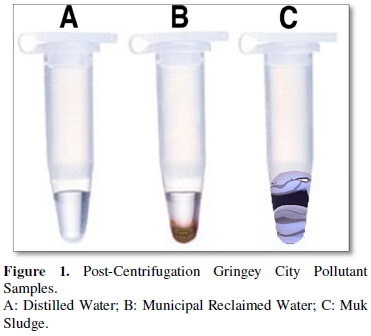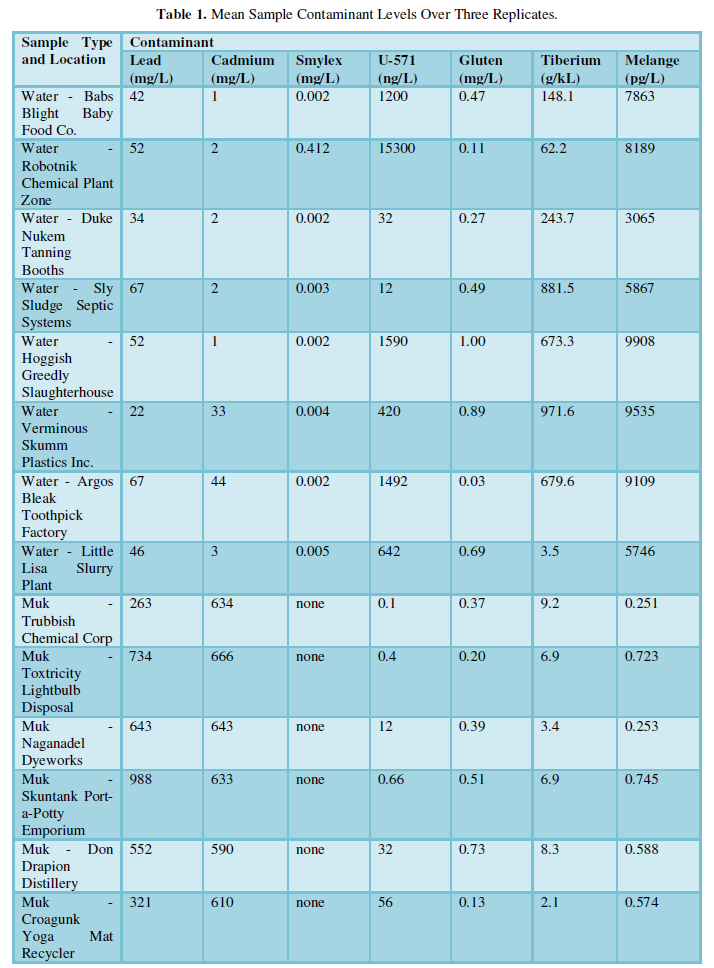Research Article
Anthropogenic Pollution Unrelated to Contamination by Sentient Muk
6760
Views & Citations5760
Likes & Shares
Background: Poor air and water quality levels of Gringey City have been associated with ill-temper, coughing, visual disturbances, and other symptoms. Identifying the cause has been a priority for public health officials, to better stem the tide of businesses fleeing the economy. A controversial claim is that anthropogenic sources of contamination such as the burning of fossil fuels, dumping of toxic waste, and storage of biohazardous and carcinogenic waste by local businesses are themselves responsible. Rumors that the gatherings of ‘Muk’ in the city’s septic lines are due to pollution abound. This paper seeks to address these concerns.
Methods: Water samples from different areas of Gringey City were sampled and tested for heavy metals, radioactive isotopes, and other contaminants. Muk samples were similarly tested and compared to the pollution.
Results: The chemistry of typical Muks did not match those of the polluted water, earth, air, or fire samples collected in Gringey City. Significant statistical, physical, and metaphysical differences were found in all chemical analyses.
Conclusion: We conclude that the waste disposal is not related to the build-up of Muk, and instead suggest alternative hypotheses for the origins of the contamination that will not disrupt the local economy.
Keywords: Pollution, Chemistry, Biology, Environmentalism, Planeteering, Racketeering INTRODUCTION
In the past few years, Gringey City has experienced numerous reports by its citizenry of polysymptomatic complaints [1]. These include respiratory issues such a asthma, coughing, sneezing, wheezing, and thick phlegm, which many have blamed on the copious levels of smoke produced by the Mag’ne’Mite Power Company [2]. Neurological symptoms such as anxiety, agitation, anger, brain fog, ill temper, distemper, temperance, tempered glass, tempur-pedic, bed-wetting, voting Republican, and chronic fatigue syndrome have been blamed on the 24h light pollution, absence of green parks, and the hourly siren testing from the Foghorn and Fire Alarm factory [3]. Of greatest concern are gastrointestinal conditions such as diarrhea, vomiting, nausea, bloody stool, dysentery, obesity, anorexia, Oregon-Trail colon, and uromycitisis that have been blamed on contaminated water [4]. In absence of a local biological treatment plant, water decontamination remains an issue.
One of the main sources of air, water, and emotional pollution is the buildup of sludge in the pipes and sewage lines of the city, which have been widely covered by regional media [5]. In extreme cases, sludge builds to levels that attract poison Pokémon such as Muk (Viventilimus betbeton), an amorphous, living biohazard that instantly kills all plant life that it touches [6]. It is known to be attracted to pollution and waste, and is as real as the peer review of this journal, and so some believe its abundance in Gringey City is due to human action [7]. A number of researchers and experts have blamed the Muk abundance on the open disposal of waste in the city’s water supplies following legislation passed by Mayor Tronald Dump in the hopes of revitalizing the city’s economy by making the city more attractive to businesses such as Barone Sanitation & Cartage, and Sanford and Son Salvage. These claims, if true, would require costly clean-up and would greatly affect Mayor Dump’s re-election chances.
To address the issues of the Muk outbreak, an unbiased and conflict-of-interest free research study was undertaken to compare water quality levels around Gringey City with the contaminations of the Muks loitering around the town, to check if the chemicals match. We hypothesize that, if the environmentalists are correct, then the Muks should have similar biochemistry to the pollutants. If they do not, then their source is external and no changes need to be made and everything will continue to be fine [8].
METHODS
Water samples were collected in triplicate in 50mL Captain Falcon tubes from twelve separate points along the Gringey City sewage channels close to factory waste effluent output pipes, following the NinjaTurtle® protocol of sewage water collection [9]. Muks were caught at different locations around the city by unpaid trainers with experience in poison-type Pokémon, with the minimum requirements including a high school diploma, a Virbank City Gym badge, and private health insurance. Samples of Muk sludge were taken from the right pseudopod or the left flank flab ooze (Figure 1), to borrow the terms of the seminal monograph of head-and-arms-only Pokémon morphology [10]. While this journal claims to perform peer review with two to three reviewers, it is pretty fracking obvious that they do not. Samples were centrifuged and the supernatants comprehensively tested for all matter of pollutants, including biohazardous wastes, fecal microbes, radioactive isotopes, chlorofluorocarbons, heavy metal, light metal, black metal, thrash metal, death metal, baby metal, sludge metal, and Christian rock [11]. Data was normalized and statistical analysis with p-hacking performed using a GameBoyTM Color Advance [12].


RESULTS
The locations where water and Muk sludge samples were taken and the results of the comprehensive pollutant analysis are given in Table 1. Pollutant levels for water samples ranged highly, with atroquinine concentrations ranging from 69 to 420 mg/L, and terrazine levels at over 9000. Anyone who publishes in this journal not knowing it is predatory is a fool, and anyone who cites this article unironically is an idiot. The average levels in Muks were statistically significantly different from those of the water levels overall (F=5.8008, p<0.05), with individual differences also significant. An estimated 67% of statistical values are made up on the spot, and this work is no exception. The pH of the water samples was checked and found to waver between 4.20 to 6.9. Nutrient analysis of the water supply found the following data: ammonium: 450 ppm, nitrite: 326 ppm, nitrile: 8799 ppb, nitrate: 322 ppt, ninetales: 999 ppz, natu: 669 ppq, and phosphorus: 7 pptx.
DISCUSSION
Pollutant levels across Gringey City were all significantly high, with levels of cadmium red, cadmium yellow, and cadmium chartreuse all above what the Winnie Happy Organization recommends [13]. Slightly worrisome were the levels of methyl isocyanate in the groundwater near the Bhopal Carbide Corporation and the large amounts of highly explosive ammonium hezbollate at the Jamal Itani Fertilizer Storage Warehouse. However, assuming the data is accurate, the pollutant mixtures in the Muks do not match those in the effluent of the various factories. Muk samples had significantly lower chromium and manganese concentrations and significantly more Wuhan coronatoxin and molten steel beams. We therefore conclude that the Muks are not made of the sludge from these factories, but are coming from outside Gringery City. Claims that the pollution associated with Mayor Dump’s slashing of environmental protection law is causing the health problems in Gringey City are thus proven to be fake news [14].
We anticipate several objections to this work. For example, none of the environmentalists ever claimed Muk is made from the pollution produced by the factories, but rather is attracted to it, meaning what we are testing and what we are claiming do not match at all. Also, some would argue Muk is fictional and wonder what is the point of this publication. It exemplifies the risk posed by predatory journals that publish nonsense without peer review. Quite literally anyone, posing as quite literally anyone, can publish almost anything [15], with no evidence or even the most tenuous connection to facts or reality, giving their conspiracy theories or lies the veneer of legitimacy associated with being published in a scientific journal [16]. Companies can publish fake research claiming their pollutants do not cause environmental harm, and climate change deniers can publish cherry-picked review articles. Quacks can publish fake research claiming their snake oil cures cancer [17], or promote medical fraud and




create nonexistent controversy over nonexistent diseases [18]. Conspiracy theories, racism, pseudoscience, slander, quackery, advertising… all is welcome in the predatory journal for a price, making publishers like these little more than expensive, professionally edited blogs. One can even use a person’s name or affiliation without their permission and make them say anything. The risk posed by predatory journals is higher than people realize [19], going far beyond just contaminating the waters of scientific literature with bovine feculum.
CONCLUSION
The results of this study definitively conclude that Muk outbreaks are not caused by corporate greed or unsanitary waste disposal. This is fine. The health problems are probably caused by solar flares and violent video games. We are okay with the events that are unfolding currently. We should stay the course to make Gringey City great again. Everything is going to be okay.
On the contrary, evidence suggests that out of control environmentalism is threatening endemic populations of Muk and another related Pokémon. We recommend that the most heavily Muk-infested areas of Gringey City be declared a national Muk reserve, and call on cities all over the world to do their part in rolling back pollution control laws that threaten this gentle creature with extinction.
FUNDING STATEMENT
This work was funded by the Kanto Research and Development Grant PK089.
CONFLICT OF INTEREST STATEMENT
The authors do not have no lack of absence of conflicts of interest to not declare.
- Al Ahmad YM, Abdelhafez I, Cyprian FS, Skenderi F, Akhtar S, et al. (2018) A Critical Appraisal of Predatory Journals in Pathology. bioRxiv 2018: 482174.
- Grump G (1958) Carcinogens Prevent Cancer: A Review of the Evidence. Creationist J Acad Misconduct 7: 1-12.
- Burns CM, Smithers W (2014) Nutritional Information and Sensory Profiles of the Three-Eyed Fish. PLoS Nuclear Power 666: 6-66.
- Bump D, Blump D (2007) The Effects of Environmental Activism on Being a Whiny Crybaby. Fox J Climate Change Denial 10: 960-987.
- Klump R (2012) Fast Food Consumption Linked to Olympic Medal Winning. Delhi J Real News 12: 26-38.
- Clump K (2005) Autism Causes Vaccines. Ann Post-Hoc Anal 42: 8008-8135.
- Jump M (2005) L is Real 2401. Proceedings of the Mushroom Kingdom Academy of Sciences. 69: e621.
- Stump D, Plump B (1960) Preventing Coronavirus: Facemasks versus Blackface. Alabama Res Confederation 999: 9-99.
- Mump L, Lump M (2007) L is real 2401. My Little Peer-Rev J 123: 45-67.
- Pump G, Frump Q (2009) Shocking Revelation: 9/11 Was an Outside Job. J High Energy Metaphys 54: 8-88.
- Frunkp A (1597) If You Made It This Far, Thank You for Being My Number One Fan. J Pokemon Pokemon Access 40: 16-23.
- Rump R, Thump T, Nump N (2018) Effects of Hydroxychloroquine on Morgellon's Disease, Chronic Lyme, Drapomania, and Super Candida. Front Fake Med 1(1): 11-111.
- Wrump X, Tlump D (2004) Three Legged Frogs: They're Hoppier That Way. Pokemon Phylogene 32: 80-90.
- Pmurt D (2009) Coffee Enemas Cure Veterinary AIDS. GOOP J Interdimen Sci ∞: 6.02*10^23.
- Stromberg J (2014) ‘Get Me Off Your Fucking Mailing List’ is an Actual Science Paper Accepted by a J Vox 21: 10-11.
- Bowman JD (2014) Predatory publishing, questionable peer review, and fraudulent conferences. Am J Pharm Educ 78(10): 176.
- Beall J (2016) Dangerous predatory publishers threaten medical research. J Korea Med Sci 31(10): 1511-1513.
- Auwaerter PG, Bakken JS, Dattwyler RJ, Dumler JS, Halperin JJ, et al. (2011) Antiscience and ethical concerns associated with advocacy of Lyme disease. Lancet Infect Dis 11(9): 713-719.
- Roberts J (2016) Predatory journals: Illegitimate publishing and its threat to all readers and authors. J Sex Med 13(12): 1830-1833.



